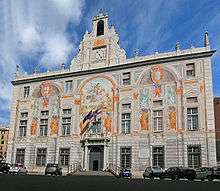Bank of Saint George
| Bank | |
| Founded | 1407 |
| Defunct | 1805 |
| Headquarters | Genoa, Italy |
| Products | Banking |

The Bank of Saint George (Italian: Casa delle compere e dei banchi di San Giorgio or informally as Ufficio di San Giorgio or Banco)[1] was a financial institution of the Republic of Genoa. Founded in 1407 to consolidate the public debt which had been escaladating due to the war with Venice for trading and financial dominance.[2] The Bank primary mission was to facilitate the management of the San Giorgio shares (luoghi). It was the oldest chartered bank in Europe and of the world. The Bank's headquarters were at the Palazzo San Giorgio, which was built in the 13th century by order of Guglielmo Boccanegra, uncle of Simone Boccanegra, the first Doge of Genoa.
Organization
A number of prominent Genoese families were involved in the establishment and governance of the Bank, including the Houses of Grimaldi & Serra. Unusually for its time, the Bank made use of a number of Jewish agents, including the Ghisolfi clan that managed certain possessions around the Black Sea.
The Bank was governed by four consuls who administered its finances and directed investments.[3] Because the Republic's ruling oligarchs were normally prominent in Bank politics, it is often difficult to determine where the Bank's influence ended and the Republic's began.
Operations
Its parent, Casa di San Georgio administered the Bank, and needed frequent liquidity injection to support the war against Venice and Genoa's ailing public finance. By 1445, the Bank suspended operations focusing on servicing the Genoese state. However, it managed to reopen for business with the general public in 1530. Many of Genoa's overseas territories were governed either directly or indirectly by the Bank. In 1453 the Republic handed over governance of Corsica, Gazaria, and a number of other possessions to Bank officials, though over the course of the fifteenth century the Republic gradually reclaimed many of its territories from Bank control.[4] The Taman peninsula remained in the control of the de Ghisolfi family, but the princes of that clan now reported to the Bank.
The Bank lent considerable sums of money to many rulers throughout Europe during the fifteenth and sixteenth centuries, gaining widespread influence. Ferdinand and Isabella maintained accounts there, as did Christopher Columbus. Before leaving for his fourth voyage, Columbus wrote a letter to the Governors of the Bank of St. George, Genoa, dated at Seville, 2 April 1502.[5] He wrote "Although my body is here my heart is always near you."[6] Charles V was heavily in debt to the Bank during much of his reign. Niccolò Machiavelli writes in book VIII, chapter XXIX of the Istorie Fiorentine:
This establishment presents an instance of what in all the republics, either described or imagined by philosophers, has never been thought of; exhibiting within the same community, and among the same citizens, liberty and tyranny, integrity and corruption, justice and injustice; for this establishment preserves in the city many ancient and venerable customs; and should it happen (as in time it easily may) that the San Giorgio should have possession of the whole city, the republic will become more distinguished than that of Venice.
In the seventeenth century the Bank became heavily involved in maritime trade, and for a time competed with such concerns as the Dutch East India Company and the English East India Company.
After Napoleon invaded Italy, he suppressed independent banks, and this led to the Bank's closure in 1805.[7]
See also
- Banco di San Giorgio (1987–2012), an unrelated bank that existed 1987–2012
Sources
- Gevurtz, Franklin A. "The Historical and Political Origins of the Corporate Board of Directors." The Berkeley Electronic Press, 2004.
- Kirk, Thomas A. (2005). Genoa and the Sea: Policy and Power in an Early Modern Maritime Republic, 1559-1684. The Johns Hopkins University Studies in Historical and Political Science. Baltimore, MD: Johns Hopkins Univ. Press. ISBN 0-8018-8083-1.
- Tai, Emily (2004). "Restitution and the Definition of a Pirate: The Case of Sologrus de Nigro". Mediterranean Historical Review. 19 (2): 34–70. doi:10.1080/0951896052000336436.
- Giuseppe Felloni and Guido Laura, Genoa and the history of finance: A series of firsts? 9 November 2004, ISBN 88-87822-16-6 (the book can be downloaded at www.giuseppefelloni.it)
Further reading
- Shaw, Christine, "Principles and Practice in the Civic Government of Fifteenth-Century Genoa", Renaissance Quarterly, Vol. 58, No. 1 (Spring 2005), pp. 45–90, The University of Chicago Press on behalf of the Renaissance Society of America, DOI: 10.1353/ren.2008.0666, JSTOR
References
- ↑ Casa delle compere e dei banchi di San Giorgio
- ↑ George Macesich, Issues in money and banking, p42. Greenwood Publishing, 2000. ISBN 978-0-275-96777-2
- ↑ Gevurtz __.
- ↑ Kirk 48.
- ↑ 'Letter from Christopher Columbus to the Governors of the Bank of St. George, Genoa. Dated at Seville, April 2nd, 1502'. Google Books. 1894. Retrieved 10 April 2011.
- ↑ The authentic letters of Columbus – Google Books. Google Books. 1894. Retrieved 29 July 2010.
- ↑ Vincent Boland, "Banking: The first chapter", FT Magazine, 18 April 2009
External links
| Wikimedia Commons has media related to Banco di San Giorgio. |
- http://www.lacasadisangiorgio.it/ - official archives of the House and Bank of St. George (Italian)